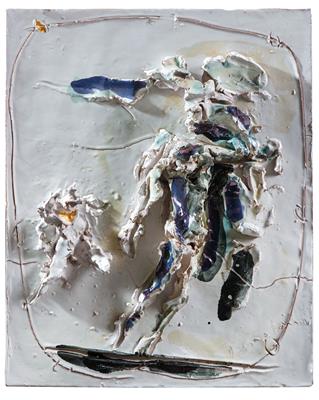Lucio Fontana *

(Rosario di Santa Fe, Argentina 1899–1968 Comabbio)
Deposizione di Cristo, 1954/56, signed, glazed ceramic, 51.5 x 42 x 11 cm, framed
This work is registered in the Fondazione Lucio Fontana, Milan under no. 424/1 and it is accompanied by a certificate of authenticity (dated 19.05.1970).
It will be included in the forthcoming Catalogue Raisonné of the works in terracotta and ceramics which is currently being compiled by the Fondazione Lucio Fontana.
Provenance:
Corrado Pizzinelli Collection, Milan
Alberto Tonelli Collection, Rome
European Private Collection
The exploration and sounding out of three-dimensionality, the setting into dynamism of space and above all an all-encompassing experience of space have played a central role in Lucio Fontana’s work from the very beginning. An interest in plasticity is already evident in the early aniline pictures – characterised by the slitting and piercing of the pictorial support. These mutilations of the integral canvas correspond to a radical conception of art that Fontana put on paper in his White Manifesto in 1946. He is concerned with the urgency of abolishing an art arrested in standstill and statics and with the proclamation of a time and space in motion. Together with other artists of the so-called spazialismo, Fontana argued that the traditional pictorial support was outdated and had to be replaced by the experience of the interaction of time, direction, sound and light in space. Following the insight that natural elements such as rays, electrons and particles act uncontrollably and with enormous force on the surface, Fontana perforates the “old” pictorial support with cuts and holes. The two-dimensionality and the illusionism of painting that goes along with it is countered by the permeability and expansive plasticity of the canvas. The work is understood as a “freely unfolding, unlimited continuum” (Fontana), whereby the boundaries between painting and sculpture are dissolved and become an allencompassing concetto spaziale.
Probably influenced by his father’s profession as a stonemason, in whose studio he worked for a time, the artist began to produce his own ceramic sculptures in 1935. While dealing with the prerogatives of spazialismo, which was dedicated to spatially oriented, abstract art, Fontana also created figurative works, characterised for the main part by depictions of scenes of the Cross. Most of these works were created at the height of the artist’s preoccupation with spatial concepts, between 1947 and the mid-1950s.
Deposizione di Cristo (1954/56) shows the appropriation of space in an expressive-dynamic gesture and can be traced through the movement of the figures in space. It depicts the upright figure of Joseph of Arimathea, who received the lifeless body of Jesus as it is pulled down from the Cross. But that is not all, the well-known subject of the Deposition from the Cross is shown in an extension of the baroque style: barring a hint of the cross and turbulent swirls, the configurations are as it were dissolved, abstracted to airy fluctuation and speed, expressing the “drama of force and movement”.
“Now we say that Fontana is baroque; he is slightly baroque because that is what his ceramic work is and that, deep down, is the baroque aspect of sculpture; this is partly because of the temptation to nrichment which leads him to handle a material with so much latent value. A tribute to the baroque was a duty… if the many small ‘battles’… are the lively and fresh baroque of today, his Madonnas and crucifixes with their billowing drapery and flashes of gold are a genuine tribute to the Baroque itself – ‘transcribed’, as musicians do with their favourite compositions from the past – a tribute to this style, the father of all those rebellions in favour of abstraction.”
(L. Ponti, Prima Astratto poi Barocco, ora spaziale, in “Domus” no. 229, vol. IV, 1948, p. 46)
The sensual experience of the pictorial theme is achieved not only through the spatial concept but also through the choice and processing of the material. The melting of the surface, the sparing use of colour and the antithetic composition lines of the figures embody an aerodynamic ambiente spaziale, in which the spontaneous and rapid processing of the wet clay mass via cuts and slits is inscribed. The elaborate modelling gives way to a fleeting technique that visualises the process of creation and the penetration into space itself.
Expert: Alessandro Rizzi
 Alessandro Rizzi
Alessandro Rizzi
+39-02-303 52 41
alessandro.rizzi@dorotheum.it
25.11.2020 - 16:00
- Dosažená cena: **
-
EUR 259.500,-
- Odhadní cena:
-
EUR 200.000,- do EUR 300.000,-
Lucio Fontana *
(Rosario di Santa Fe, Argentina 1899–1968 Comabbio)
Deposizione di Cristo, 1954/56, signed, glazed ceramic, 51.5 x 42 x 11 cm, framed
This work is registered in the Fondazione Lucio Fontana, Milan under no. 424/1 and it is accompanied by a certificate of authenticity (dated 19.05.1970).
It will be included in the forthcoming Catalogue Raisonné of the works in terracotta and ceramics which is currently being compiled by the Fondazione Lucio Fontana.
Provenance:
Corrado Pizzinelli Collection, Milan
Alberto Tonelli Collection, Rome
European Private Collection
The exploration and sounding out of three-dimensionality, the setting into dynamism of space and above all an all-encompassing experience of space have played a central role in Lucio Fontana’s work from the very beginning. An interest in plasticity is already evident in the early aniline pictures – characterised by the slitting and piercing of the pictorial support. These mutilations of the integral canvas correspond to a radical conception of art that Fontana put on paper in his White Manifesto in 1946. He is concerned with the urgency of abolishing an art arrested in standstill and statics and with the proclamation of a time and space in motion. Together with other artists of the so-called spazialismo, Fontana argued that the traditional pictorial support was outdated and had to be replaced by the experience of the interaction of time, direction, sound and light in space. Following the insight that natural elements such as rays, electrons and particles act uncontrollably and with enormous force on the surface, Fontana perforates the “old” pictorial support with cuts and holes. The two-dimensionality and the illusionism of painting that goes along with it is countered by the permeability and expansive plasticity of the canvas. The work is understood as a “freely unfolding, unlimited continuum” (Fontana), whereby the boundaries between painting and sculpture are dissolved and become an allencompassing concetto spaziale.
Probably influenced by his father’s profession as a stonemason, in whose studio he worked for a time, the artist began to produce his own ceramic sculptures in 1935. While dealing with the prerogatives of spazialismo, which was dedicated to spatially oriented, abstract art, Fontana also created figurative works, characterised for the main part by depictions of scenes of the Cross. Most of these works were created at the height of the artist’s preoccupation with spatial concepts, between 1947 and the mid-1950s.
Deposizione di Cristo (1954/56) shows the appropriation of space in an expressive-dynamic gesture and can be traced through the movement of the figures in space. It depicts the upright figure of Joseph of Arimathea, who received the lifeless body of Jesus as it is pulled down from the Cross. But that is not all, the well-known subject of the Deposition from the Cross is shown in an extension of the baroque style: barring a hint of the cross and turbulent swirls, the configurations are as it were dissolved, abstracted to airy fluctuation and speed, expressing the “drama of force and movement”.
“Now we say that Fontana is baroque; he is slightly baroque because that is what his ceramic work is and that, deep down, is the baroque aspect of sculpture; this is partly because of the temptation to nrichment which leads him to handle a material with so much latent value. A tribute to the baroque was a duty… if the many small ‘battles’… are the lively and fresh baroque of today, his Madonnas and crucifixes with their billowing drapery and flashes of gold are a genuine tribute to the Baroque itself – ‘transcribed’, as musicians do with their favourite compositions from the past – a tribute to this style, the father of all those rebellions in favour of abstraction.”
(L. Ponti, Prima Astratto poi Barocco, ora spaziale, in “Domus” no. 229, vol. IV, 1948, p. 46)
The sensual experience of the pictorial theme is achieved not only through the spatial concept but also through the choice and processing of the material. The melting of the surface, the sparing use of colour and the antithetic composition lines of the figures embody an aerodynamic ambiente spaziale, in which the spontaneous and rapid processing of the wet clay mass via cuts and slits is inscribed. The elaborate modelling gives way to a fleeting technique that visualises the process of creation and the penetration into space itself.
Expert: Alessandro Rizzi
 Alessandro Rizzi
Alessandro Rizzi
+39-02-303 52 41
alessandro.rizzi@dorotheum.it
|
Horká linka kupujících
Po-Pá: 10.00 - 17.00
kundendienst@dorotheum.at +43 1 515 60 200 |
| Aukce: | Současné umění I |
| Typ aukce: | Sálová aukce s Live bidding |
| Datum: | 25.11.2020 - 16:00 |
| Místo konání aukce: | Wien | Palais Dorotheum |
| Prohlídka: | online |
** Kupní cena vč. poplatku kupujícího a DPH
Není již možné podávat příkazy ke koupi přes internet. Aukce se právě připravuje resp. byla již uskutečněna.
